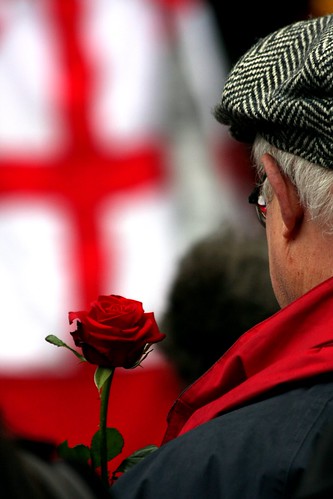Saint George killed a dragon, saved a princess and became the patron saint of England. Tomorrow he’ll be honoured with no small amount of flag-waving, beer-drinking and, you’d think, a fair few A&E visits. But who’s the man behind the myth, the man Shakespeare’s Henry V evoked so brilliantly at Agincourt?
George – good, strong English name, right? Wrong:George was born into Christian nobility in Cappadocia, a lunar landscape in central Turkey best known for its ‘fairy chimneys’, around the middle of the 2nd century AD. In truth George’s early years are about as ephemeral as Emile Heskey’s England career, but as the son of a high-ranking soldier he soon worked his way into the Roman Emperor Diocletian’s personal entourage.
George’s military career is ill-documented, but Diocletian issued an edict in 302 declaring that every Christian soldier be rounded up and made to convert to the Roman pagan faith. George refused to renounce Christ, and was summarily tortured and executed by beheading in Palestine a year later, on April 23. Various sources claim these tortures were particularly nasty, including lasceration on a wheel of swords and being tossed into a burning cauldron, though they’re not the most reliable.
George’s brave refusal led many to honour him as a martyr. A church was consecrated in Lydda, Palestine by Emperor Constantine (ruled 306-337; introduced Christianity officially into the Roman Empire), to ‘a man of the highest distinction’, but his identity has never been revealed. Yet George wasn’t made a saint until 494, and it wasn’t until the 11th century that Crusaders reignited the story of George, adding the famous tale of his slaying a dragon to save a princess. In 1222 the Synod of Oxford declared the day of Saint George’s death a feast in England, a decision that endures to this day.
Today it’s sad that more isn’t done to celebrate St. George’s Day. Yes, we can complain about the hijacking of the English flag by far-right loons like Nick Griffin, but apathy in the face of globalisation and turgid politics is surely to blame. It’s a shame England doesn’t put the same intensity into its patron saint as the Irish do on St. Patrick’s Day, or the Scots do on Burns Night. Yet a whispered post-modern patriotism is beginning to burble below the surface in Britain, sparked this year by a hotly-contested election and the forthcoming World Cup.
The St. George’s Day website aims to take back the flag from the right, and claims to have over a million voters in its poll to make tomorrow a public holiday. The Turkish town of Urgup, which claims to be the home of George’s dragon-slaying exploits, has invited English villages with ties to the saint to twin with it. “We are very proud of being connected to such a famous and well known character, who has since become the patron saint of England,” says mayor Fahri Yildiz. “It is good to know that the tradition of Saint George, and the legend of Saint George and the Dragon is alive and well there.”
So there’s the history of our patron saint, however swathed in mystery. His day might fall on a Friday night this year, but wherever you’re drinking tomorrow raise a glass to George: the old boy’s had a tough few decades.
